
A collaboration between the School and Edinburgh College of Art has resulted in an award-winning photograph.
School lab managers Sarah Brown and Joe Rendle worked with Product Design student Joshua Notley to produce "Floral attraction: A world without bees".
The photograph won second prize in the Agri-Science category of the ‘Picture This’ competition run by Edinburgh Research and Innovation, which invited Edinburgh staff and students to submit images in a range of categories relating to the University’s research activities.
"The photograph was taken for Joshua Notley's course work for his studies at ECA in collaboration with technical support and editing from Joe and myself, so Josh is the creative one although we all have an interest in photography." Sarah Brown
"Floral attraction: A world without bees"
A Van de Graaf generator produces a strong electrostatic charge. This photograph illustrates the generator attracting a stream of pollen onto its metal dome. We propose an idea utilising similar technology for the collection of pollen from plants. In an environmental landscape where bee populations are dwindling the sustained pollination of plants should be considered. When the dome of the Van De Graaf generator is earthed the pollen is no longer held in place by the electrostatic force and falls from the surface, ready for collection and dissemination as required.
Image gallery
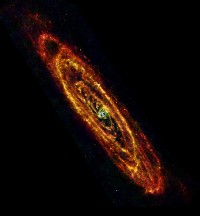
Researchers have found that the Milky Way is approximately half the weight of the neighbouring Andromeda galaxy.
For the first time, scientists have been able to precisely measure the mass of the galaxy that contains our solar system. They have found that the Milky Way is approximately half the weight of the neighbouring Andromeda galaxy, which has a similar structure to our own. The Milky Way and Andromeda are the two largest in a region of galaxies which astronomers call the Local Group.
A team of scientists led by the University of Edinburgh used recently-published data on the known distances between galaxies in the Local Group – as well as their velocities – to calculate the total masses of Andromeda and the Milky Way. Previous studies were only able to measure the mass enclosed within both galaxies’ inner regions. In this new study, researchers were also able to work out the mass of invisible matter found in the outer regions of both galaxies, and reveal their total weights. They say 90 per cent of both galaxies’ matter is invisible.
“We always suspected that Andromeda is more massive than the Milky Way, but weighting both galaxies simultaneously proved to be extremely challenging. Our study combined recent measurements of the relative motion between our galaxy and Andromeda with the largest catalogue of nearby galaxies ever compiled to make this possible.” Dr Jorge Peñarrubia, School of Physics and Astronomy, who led the study.
Scientists say that Andromeda’s extra weight must be present in the form of dark matter, a little-understood invisible substance which makes up most of the outer regions of galaxies. They estimate that Andromeda contains twice as much dark matter as the Milky Way, causing it to be twice as heavy.
Researchers say their work should help them learn more about how the outer regions of galaxies are structured. Although both galaxies appear to be of similar dimensions, until now scientists had been unable to prove which is larger.
The study, published in the journal Monthly Notices of the Royal Astronomical Society, was carried out in collaboration with the University of British Colombia, Carnegie Mellon University and NRC Herzberg Institute of Astrophysics. The work was supported by the UK’s Science and Technology Facilities Council. Findings from the study are supported by research led by Jonathan Diaz at the University of Cambridge, which used different data and methods and produced very similar results.
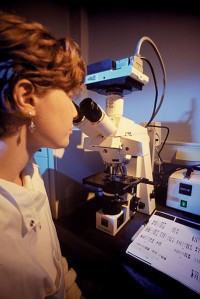
The School invites expressions of interest from potential applicants for the STFC Ernest Rutherford Fellowships and the Royal Society University Research Fellowships. Both schemes provide five years' funding for outstanding researchers.
STFC Ernest Rutherford Fellowship
Applicants to the STFC Ernest Rutherford Fellowship must have a PhD and a minimum of five years' research experience from the start of the postgraduate programme leading to the award of a PhD. Holders of a permanent academic position are not eligible.
Royal Society University Research Fellowship
For the Royal Society University Research Fellowship, applicants must have between three and eight years of research experience since their PhD by the closing date of the round.
How to apply
Expressions of interest must include a draft project proposal and a CV. This should be submitted to the admin-researchandfinance [at] ph.ed.ac.uk (Research and Finance team) by Friday, 22nd August 2014.
Candidates submitting after this date cannot be considered.
One hundred high school students recently participated in a week of activities at the University of Edinburgh as part of a summer school organised by the Sutton Trust.
The Sutton Trust identifies and pilots programmes to help non-privileged children; undertakes independent and robust evaluations; and aims to influence Government education policy and education spending to improve educational opportunities for young people from low and middle income homes.
Twenty-four summer students followed the “physics stream” that was organised by researchers from the School of Physics & Astronomy. Each morning, students attended lectures that introduced some of the subjects that are taught at University while in the afternoon a series of workshops allowed them to explore these subjects in more detail.
Physics masterclass
Greig Cowan and Flavia Dias from the School's experimental particle physics group discussed the physics principles that are explored and tested at research laboratories such as CERN. The students were given the chance to analyse some of the data from the ATLAS experiment at CERN during a “physics masterclass”. They were challenged to look through the data to find the characteristic signature of the decay of the Higgs boson, the same particle that was discovered at CERN two years ago!
Complex systems
Richard Blythe introduced complex interacting systems and the chaotic behaviour they can exhibit. Armed only with dice and pieces of card, the students ran a Monte Carlo model of traders in an economy, and found that even when the rules treated all players equally, a few traders ended up very rich whilst rather more had no money at all. This illustrates the fundamental principle that a physical system is more likely to be in a state with low energy than one with high energy. In turn, this underpins our modern understanding of how structures arise in condensed matter physics.
The impact of supercomputers
David Henty presented an overview of what supercomputers are and their impact on the world. This was followed by a number of practical activities each supervised by a member of EPCC's staff. David showed the students a number of old supercomputer motherboards, indicating the many processors that were previously used to achieve a high performance. Eilidh Troup showed the potential complexity of programming these systems by using a numbered ball sorting algorithm - students were given balls to sort, each of them acting out the part of a different processor. Alistair Grant used a geoboard to show various aspects of networking. Finally Mario Antonioletti had a dinosaur-racing demo where students could configure a model of argentinosaurus, a 4-legged dinosaur. This application shows parallelism being harnessed by running the processing of the configured dinosaur behind the scenes in parallel.
The students were also engaged in the preparation of a poster to present on the last day of the school. All the physics groups were very excited to share their experience with the other participants of the school, which included students interested in a wide variety of disciplines, ranging from informatics to philosophy.
Find out more
The success of this event bodes well for future participation of the School with the Sutton Trust. More information can be found here:
www.ed.ac.uk/schools-departments/student-recruitment/widening-participation/projects/stss
Image gallery
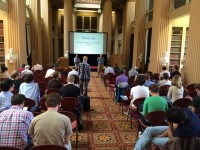
Researchers from the School's experimental particle physics group recently organised the 15th International Conference on B-Physics at Frontier Machines (Beauty 2014)
The event was held at the Playfair Library at the University of Edinburgh and supported by the Higgs Centre. The Beauty 2014 conference reviewed results in the field of B-physics and CP-violation, and explored the physics potential of existing and upcoming B-physics experiments at new particle accelerator facilities. The CERN-based LHCb experiment (which comprises a strong Edinburgh group) presented its latest results on the observation of a spin-3 meson, the first time such an object has been observed.
A live video link-up with CERN took place on Thursday, with a dedicated discussion about the physics results being presented in Edinburgh. This gave the general public a chance to hear directly from the scientists making the measurements and to ask them questions. You can watch an online recording of the broadcast.
"Two main results were presented, both from the LHCb experiment that we work on in Edinburgh. The first was the first observation of a heavy flavored spin-3 particle, observed in the decay of a B_s meson. In quantum mechanics, spin is an intrinsic form of angular momentum carried by the particle, just like all particles also have a mass. This is the first time that any spin-3 particle has been seen to be produced in B meson decays and shows the power of the LHCb data to perform spectroscopy of heavy flavoured mesons." Dr Greig Cowan, Particle Physics Experiment group.
Confirmation of an exotic resonance composed of 4 quarks was also presented at the conference.
In addition to the LHCb results, the ATLAS, CMS, Belle, BaBar, CDF and D0 experiments also showed their latest measurements, demonstrating the great strength in the field as we work together to understand the fundamental theories of the Universe. Theoretical physicists helped to shed further light on recent interesting and unexpected results by showing how possible new physics theories could accommodate these anomalies. In addition, local PhD students were given the chance to present their own work during a poster session.
“I really enjoyed the conference as it allowed me to get a good overview of many different aspects of my subject. Getting the chance to present my own research to the community, in the form of a poster and short presentation, was excellent experience for thinking about how best to communicate my thesis subject. This will be very useful in the future!" Adam Morris, PhD student, Particle Physics Experiment group
The conference not only allowed the scientists to discuss the latest results, but also gave them the opportunity to socialise together and get to explore Edinburgh, Scottish culture (including whisky) and the surrounding area. You can see the Twitter posts and photos taken during the week here: https://twitter.com/hashtag/beauty2014?src=hash
"Beauty 2014 was a huge success with lots of new results presented. We have received lots of very positive feedback from participants who enjoyed very much the conference which took place in the historic Playfair Library. This venue allowed for easy interactions between scientists with lots of excellent discussion after talks, but also during coffee and lunches. " Prof. Franz Muheim, Particle Physics Experiment group, who chaired the local organising committee.
About LHCb
LHCb is an experiment set up to explore what happened after the Big Bang that allowed matter to survive and build the Universe we inhabit today
Fourteen billion years ago, the Universe began with a bang. Crammed within an infinitely small space, energy coalesced to form equal quantities of matter and antimatter. But as the Universe cooled and expanded, its composition changed. Just one second after the Big Bang, antimatter had all but disappeared, leaving matter to form everything that we see around us — from the stars and galaxies, to the Earth and all life that it supports.
The conference ran from 14th‑18th July 2014 at the Playfair Library in Edinburgh.
Image gallery
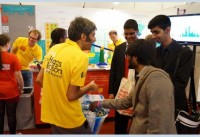
Researchers from the School's Particle Physics groups took part in "The Higgs Boson and Beyond" exhibit at the Royal Society Exhibition in London in July.
Fifteen thousand people visited the week-long Summer Science Exhibition, including the general public and school groups as well as evening soirees with Royal Society Fellows and VIPs. The School's Particle Physics Experiment group was heavily involved in the organisation of the exhibition this year.
The exhibit showed how recent measurements at the ATLAS and CMS experiments of the Large Hadron Collider (LHC) earned the 2013 Nobel prize for Physics for Peter Higgs and Francois Englert. Demonstrations also explained how the Higgs Boson gives clues to new physics that lies beyond what we already know. This was done through various activities commissioned especially for the exhibit, that allowed visitors to play with (and make) knitted fundamental particles, measure the Higgs mass as 70s physicists would have done, play Spinball to learn about the Higgs spin, and to win prizes by finding rare-decays of the Higgs Boson (in pin-badge form) and much much more.
"It was a great honour to be a part of the Summer Science Higgs boson exhibition! I found it extremely rewarding to see understanding dawn in the eyes of curious children and take part in many fruitful discussions with interested visitors.
"As a scientist, communicating with the public helps remind me of the 'big picture' of the CERN laboratory and its experiments, and I am privileged in turn to grow an excitement for particle physics outside the scientific community." Flavia Dias, Particle Physics Experiment group, School of Physics
Wahid Bhimji co-led the overall exhibition planning, bringing together activities from all 18 particle physics groups in the UK. Flavia Dias led on the online presence, including the popular Twitter feed and Q&A. As well as Flavia and Wahid, Edinburgh group members Victoria Martin and Ben Wynne also demonstrated at the exhibit.
Further information
RSE event website: Summer Science: Higgs Boson
The Higgs Boson and Beyond booklet
The Higgs Boson and Beyond website
The Higgs Boson and Beyond video
The exhibit and booklet were co-sponsored by the University of Edinburgh and the Higgs Centre, together with the other UK universities involved and STFC.
Image gallery
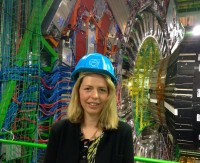
Dr Victoria Martin of the School's Particle Physics Experiment group has joined the Young Academy of Scotland, the Royal Society of Scotland's mutli-disciplinary forum.
She joins the School's six other members: Cait McPhee, Rosalind Allen, Duncan Forgan, Tiffany Wood, Job Thijssen, and Catherine Heymans.
"I am delighted to be appointed to the Young Academy of Scotland. I look forward to working with fellow young leaders from around Scotland on diverse issues such as research and education policy, engagement with the media and the implications of constitutional reform." Victoria Martin
The Young Academy of Scotland
The RSE Young Academy of Scotland fosters interdisciplinary activities among emerging leaders from the disciplines of science and humanities, the professions, the arts, business and civil society. Established by the Royal Society of Edinburgh in 2011, the Young Academy of Scotland provides a platform for able and innovative young entrepreneurs, professionals and academics to develop a coherent and influential voice, and to address the most challenging issues facing society in Scotland and beyond.
The Young Academy provides a means of reaching beyond the professional environments in which members work, thus contributing to policy and practice in all areas. It provides an opportunity for its members to interact across disciplines and professions with decision makers, opinion formers and experts, business leaders, funding bodies, national institutions, the public and the media within Scotland, the UK and internationally.
The Young Academy of Scotland is part of a growing international movement in which national academies are establishing young academies across Europe and beyond.
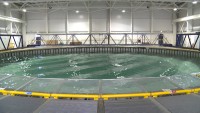
The School of Physics & Astronomy has made a short film called Breaking Waves to coincide with the opening of the new Flowave tank at the University.
Theoretical research into the generation of three-dimensional random seas was carried out in the School (then the Department of Physics) in the early 1980s and at about the same time the School also developed new optical techniques for the measurement of complex water waves.
The film explains the fundamentals of how waves are generated in the real sea and reproduced in a wave tank. It also gives a whistle-stop tour of some of the new wave energy devices under development in Scotland including, for example, new footage taken inside Pelamis on the island of Hoy in Orkney.
Breaking Waves will first be shown in Satrosphere Science Centre in Aberdeen during the summer. For more details contact c.a.greated [at] ed.ac.uk (Clive Greated).
Flowave
The FloWave Ocean Energy Research Facility is a world-unique facility for testing and de-risking marine energy technologies and projects.
The tank and equipment
The heart of FloWave is a 30m circular concrete basin containing the 25m diameter wave and current tank. The 5m deep tank contains 2.4 million litres of fresh water and is circumferentially ringed by 168 absorbing wave makers. Additionally, twenty-eight submerged flow-drive units can simultaneously and independently drive current across the tank in any relative direction, with maximum current velocities of 1.6 metres per second. A rising tank floor and overhead crane enable quick and easy installation of individual devices, or arrays of wave or tidal current generators.
Image gallery

The MASE (Mars Analogues for Space Exploration) research project based within the UK Centre for Astrobiology will assess the habitability of Mars by studying how life survives in extreme environments on Earth. Dr Petra Schwendner, who plays a major role in the scientific co-ordination of MASE, explains the work of the project.
I have a strong background in the enrichment of anaerobic microorganisms with a focus on astrobiology. Over the next 3 years I will be using a diverse set of different present-day Earth-Mars analogue environments to help further the assessment of the habitability of Mars.
Detecting life of Mars, and investigating whether it was ever there, depends on knowledge of whether the combined environmental stresses experienced on Mars are compatible with life and whether a record of that life could ever be detected. Therefore, I will obtain samples from sites including the cold sulphidic springs of the Sippenauer Moor and Islinger Muehlbach in Germany, subsurface environments at 1.1 km depth in the Boulby salt mine (UK), permafrost in Canada and Russia, acidic cold lakes in Iceland, and the Rio Tinto sediments in Spain.
Each of these environments is characterized by exhibiting environmental extremes like low temperature, aridity, high salinity, acidity and low nutrient availability. Once I have obtained samples, I will try to isolate and characterize microorganisms that can thrive under anaerobic conditions. Future goals are to study their responses to realistic combined environmental stresses that might have been experienced in habitable environments on Mars and their potential for fossilisation on Mars and their detectability.
l am looking forward to being part of this promising collaborative research project involving partners from across Europe. To find out more, see our MASE website.
The University of Edinburgh is the scientific coordinator of MASE. This 2.5million euro project is supported by the Seventh Framework Programme (FP7) of the European Community for research, technological development and demonstration activities.
Image gallery
![Professors Peter Higgs and Francoise Englert during a press conference ahead of the Nobel Prize ceremony in Stockholm. [© Victoria Henriksson/The Royal Swedish Academy of Sciences]](https://www.ph.ed.ac.uk/sites/default/files/styles/news_article_image/public/legacy/Higgs%20Englert%202013.jpg?itok=um95YVn_)
Celebrated Nobel laureates Professors Peter Higgs and Francois Englert are to receive honorary degrees at a ceremony in Edinburgh this weekend.
Professor Higgs, of the University of Edinburgh, and Professor Englert, of Université Libre de Bruxelles, are to receive doctorates in science from one another’s institutions, at a graduation ceremony in the University of Edinburgh’s McEwan Hall.
Professors Higgs and Englert won the Nobel Prize for Physics in 2013 for independently discovering a mechanism that enables elementary particles to acquire mass.
The new subatomic particle predicted by the mechanism, the Brout-Englert-Higgs boson, was confirmed to exist in 2012 following ground-breaking experiments at the European Organization for Nuclear Research (CERN) near Geneva.
At the event, Professor Sir Tom Kibble from Imperial College London, who also developed the theory of the mechanism, will receive a Royal Medal from the Royal Society of Edinburgh.
Professor Rolf-Dieter Heuer, Director-General of CERN, will be awarded an honorary degree from the University of Edinburgh.
At the ceremony, Professor Higgs will be awarded the Freedom of the City of Edinburgh by the Lord Provost, the Rt Hon Donald Wilson.

